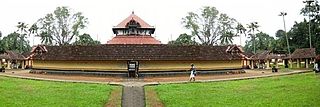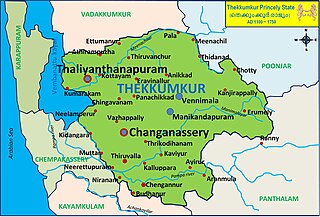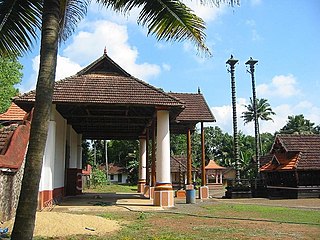
Kottayam is one of 14 districts in the Indian state of Kerala. Kottayam district comprises six municipal towns: Kottayam, Changanassery, Pala, Erattupetta, Ettumanoor, and Vaikom. It is the only district in Kerala that does not border either the Arabian Sea or another Indian state.

Changanassery, is a municipality in the Kottayam district of Kerala, India. It is located 17 km (10.6 mi) south of the district headquarters in Kottayam and about 115 km (71.5 mi) north of the state capital Thiruvananthapuram. As per the 2011 Indian census, Changanassery has a population of 47,485 people, and a population density of 3,517/km2 (9,110/sq mi).
Pallom is a block situated 6.5 km south of Kottayam town and 12.4 km north of Changanassery, in the Kerala State. The nearest airport is the Cochin Nedumbassery International Airport which can be reached within 2 hours. Nearest local railway station is Chingavanam (3.6 km) and Major railway station is Kottayam (6 km).

Kottayam is a city in the Kottayam district of Kerala, India. It is the district headquarters of the district and is located about 151 km (93.8 mi) north of the state capital Thiruvananthapuram. As per the 2011 Indian census, Kottayam has a population of 489,615 people, and a population density of 4,533/km2 (11,740/sq mi). The total Kottayam Metropolitan area has a population of 802,419 people, and a population density of 3,647/km2 (9,450/sq mi).

Kaduthuruthy is a town in Kottayam District in the state of Kerala, India.

The Kingdom of Thekkumkur was an independent kingdom in the southern part of Kerala in India from 1103 CE until 1750 CE. It was ruled by the Thekkumkur Royal Family. Thekkumkur lies between the Meenachil River and the Pamba River, from the Western Ghats to the Vembanad Kayal. Thekkumkur emerged as a result of administrative changes in the princely states at the end of the Chera Kulasekhara dynasty of Mahodayapuram. The literal meaning of the title is the southern regent and the attribute southern distinguished them from another kingdom known as Vadakkumkur which bordered it in the northern side. The royal household, Thekkumkur Kovilakam, were at Vennimala and Manikandapuram near Puthuppally, later it shifted to Neerazhi Palace at Puzhavathu of Changanassery and Thalilkotta at Thaliyanthanapuram (Kottayam).

The Thirunakkara Mahadevar Temple situated in the heart of Kottayam is one of the 108 revered Shivalayas in central Kerala, India. The temple is about 500 years old and was built by the Raja of Thekkumkur. It also preserves a number of unique sculptures and murals of various Hindu deities. A common belief is that the idol of Shiva here is installed by Parashurama. The Thekkumkur royal family considered the idol as their paradevatha in the form of "Thirunakkara thevar"

Kandiyoor Sree Mahadeva Temple is an ancient Shiva temple situated in Kandiyoor near Mavelikkara on the banks of Achankovil river. Kandiyoor was once the capital of the Odanadu kingdom. The temple and region are related to the history of ancient Buddhism in Kerala. Mattom Sree Mahadeva Temple also known as shiva nada is 1 kilometre (0.62 mi) west of Mavelikkara town north of State Highway 6. It is spread across an area of 7.5 acres (3.0 ha).
Chingavanam is a suburb of Kottayam city between Kottayam and Changanassery in Kottayam district of Kerala state, India.
Poonjar dynasty was one of the royal dynasties in medieval Kerala descended from the Pandya kings of Madurai. History has it that Manavikrama Kulasekara Perumal, a Pandya king as the sole founder of the dynasty. It was a minor principality in the central Travancore region which covered the parts of present-day Dindigul, Cumbum, Kudallor, Bodinayakkanur, Vandiperiyar, Peerumedu and Kannan Devan hills.
Reflecting the religious constitution of the population, a large number of Hindu temples and Christian churches dot the townscape of Kottayam district. Some of them are the Thirunakkara Mahadeva temple, Kumaranalloor Devi temple, Thiruvarrpu Sri Krishna Temple, Thaliyil Mahadeva Temple, Pallippurathukavu Bhagavathi Temple, Elia Cathedral, Kottayam Valiya Pally, Manarcad Cathedral, Cheriya Palli, CSI Holy Trinity cathedral, Puthuppally St. George Church and Thazhathangadi Juma Masjid. All the temples of Kottayam were also built under royal patronage of Hinduism during the 2nd millennium.

Parippu Mahadeva Temple is a Hindu temple located in Parippu in Aymanam panchayath of Kottayam district, in the Indian state of Kerala. This temple mentioned as Nalparappil in the renowned Shivalaya stotra is closely related to Thekkumkur raja. Currently it is administered by Travancore Devaswom Board. Bhadrakali Mattappally Nambudiri holds the tantric rights of the temple.

Kidangoor Subramanya Swami Temple is an ancient Hindu temple located in Kidangoor near Ayarkkunnam in Kottayam district in the Indian state of Kerala. It is one of the renowned Subramanya temples in Kerala which is estimated to be at least 1500 years old.

Mannar Thrikkuratti Mahadeva Temple an ancient Hindu temple dedicated to Shiva is situated on the banks of the Pampa river at Mannar of Alappuzha in Kerala state in India. The presiding deity of the temple is Shiva, located in main sanctum sanatorium, facing East. According to folklore, sage Parashurama has installed the idol. The temple is one of the 108 famous Shiva temples in Kerala. It is believed that the mammoth temple compound wall was built by a troupe of Bhootas of Lord Paramasiva in one night. The temple was built by King Maandhatha of Ishyaku Dynasty (Sooryavamsam).

Niranam Thrikkapaleeswaram Dakshinamurthy Temple, an ancient Hindu temple dedicated to Lord Shiva is situated on the banks of the Pampa river at Niranam of Pathanamthitta District in Kerala state in India. This temple is a classic example of the Dravidian style of architecture. The temple is the abode of Dakshinamurthy. The deity of Thrikkapaleeswaram is located in main Sanctum Sanctorum facing east. According to folklore, sage Parasurama has installed the idol. The temple is a part of the 108 famous Shiva temples in Kerala. This is one of the three Thrikkapaleeswaram temples mentioned in 108 Shiva temples. Two other temples situated in Peralassery in Kannur district and Nadapuram in Kozhikode district.

Keezhtali Mahadeva Temple is an ancient Hindu temple dedicated to Shiva situated in Kodungalloor of Thrissur District in Kerala state in India; it was one of the important temples in Chera Kingdom, being one of a complex of 108. According to folklore, sage Parashurama himself installed the idol of Shiva. The temple is one of the four thali temples mentioned in the 108 Shiva temples. The temple is also known as the Keetholi Temple.

The Battle of Changanacherry was a battle between the kingdoms of Thekkumkur and Travancore in September 1749. Defeat in this decisive battle led to Thekkumkur losing its dominance and expanding the Tranvancore empire to the southern border of the river Meenachilar.

Neerazhi Palace was the royal palace of the Thekkumkur kingdom. Palace is located at Puzhavathu in Changanassery. The palace was used by the Thekkumkur dynasty until 1750 and later by the Parappanad dynasty who settled in Changanassery from North Malabar. It was here that the last king of Thekkumkur, Aditya Varman Manikandan escaped to Nattassery of Kottayam in the Travancore invasion of 1790. The Neerazhi palace was earlier known as Neerazhikettu.

Vennimala is a small village located in Puthuppally Grama Panchayath of the Kottayam district in Kerala. Vennimala is 16 kilometres (9.9 mi) east of Kottayam. It lies between the towns of Western Kerala and the mountains of the Western Ghats. Vennimala was once a dense forest.

Aditya Varma Manikandan popularly known as Aditya Varman, was the last ruling Maharaja of the Princely State of Thekkumkur. He was the ruler until September 1749 when the king of Travancore Anizham Thirunal Marthanda Varma ousted him from Neerazi Palace at the Battle of Changanassery. Thekkumkur kings were known as Manikandan. The goddess was Cheruvally Bhagavathi in the space. The official residence of Sri Aditya Varma was Neerazi Palace.

















